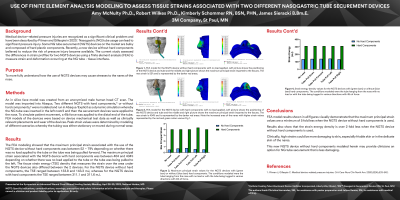Laboratory Research
(LR-032) Use of Finite Element Analysis Modeling to Assess Tissue Strains Associated with Two Different Nasogastric Tube Securement Devices
Friday, April 28, 2023
7:15 PM - 8:30 PM East Coast USA Time

Robert Wilkes, PhD – 3M Company; Kimberly Schommer, RN, BSN, PHN, VA-BC – 3M Company; James Sieracki, B.Bm.E. – 3M Company
Introduction: Medical device–related pressure injuries are recognized as a significant clinical problem and have been described by Pitman and Gillespie in 2020.1 Nasogastric tube (NG Tube) usage can lead to significant pressure injury. Some NG tube securement devices (NGTS) on the market are bulky and composed of hard plastic components. Recently a new device without hard components believed to reduce the risk of pressure injury became available. The current study assessed the differences in strain profiles for two NGTS using a finite element analysis (FEA) to measure strain and deformation occurring at the NG Tube - tissue interface.
Methods: Two different NGTS with hard components,* or without hard components,† were modelled. FEA models of the devices were based on device mechanical test data as well as clinically relevant placements and wear of the devices. Peak strain values were determined by modeling of different scenarios whereby the tubing is moved during wear.
Results: The FEA modeling showed peak strains ranging from 51 – 529% for the 2 NGTS depending on how the tubing was situated. The peak strain was always higher for the hard plastic device. For example, when the tube was hanging from the devices, the weight of the NG tube was associated with 51 and 529% peak tissue strain for the soft vs device with hard plastic, respectively. If the NG Tube was tugged to the right, the peak tissue strain for the soft vs device with hard plastic was 55 vs 337%, respectively.
Discussion: NGTS may, in certain instances, be related to pressure injury. Therefore, it is important to choose the best product for the intended job while providing the least potential damage to the tissue. The NGTS without any hard components may provide an important option for the reduction of pressure injury during normal usage.
Methods: Two different NGTS with hard components,* or without hard components,† were modelled. FEA models of the devices were based on device mechanical test data as well as clinically relevant placements and wear of the devices. Peak strain values were determined by modeling of different scenarios whereby the tubing is moved during wear.
Results: The FEA modeling showed peak strains ranging from 51 – 529% for the 2 NGTS depending on how the tubing was situated. The peak strain was always higher for the hard plastic device. For example, when the tube was hanging from the devices, the weight of the NG tube was associated with 51 and 529% peak tissue strain for the soft vs device with hard plastic, respectively. If the NG Tube was tugged to the right, the peak tissue strain for the soft vs device with hard plastic was 55 vs 337%, respectively.
Discussion: NGTS may, in certain instances, be related to pressure injury. Therefore, it is important to choose the best product for the intended job while providing the least potential damage to the tissue. The NGTS without any hard components may provide an important option for the reduction of pressure injury during normal usage.

.png)